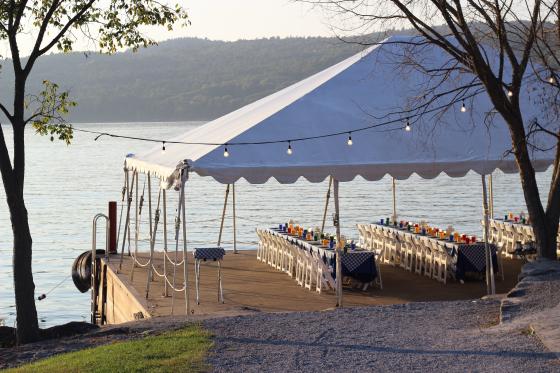Posted October 2, 2017 at 07:13am by Helen Labun
Local Fish Takes Its Place on the Menu

On Sunday, September 24th, the Vermont Fresh Network (VFN), with Lake Champlain International (LCI), presented a celebration of Lake and Land with a public dinner at Basin Harbor in Vergennes. This event was the last in a summertime series for the 2017 FishOn! Program, which brought food professionals on chartered fishing trips on Lake Champlain to learn more about the lake as a food source and have conversations about how human activities impact lake health.
Meghan Sheridan led FishOn! this summer. “This program really began 4 years ago, when LCI came to us [VFN] with the question of why Vermont chefs weren’t using more local fish? Since that time we’ve been working with them to build a better appreciation for local fish in local dining,” she explains.
Lake Champlain is a historic source of food for our region. Lake Champlain fish are on menus throughout the Great Lakes region and fish fries there are a popular tradition. Vermont chefs, on the other hand, have been less aware (or not at all aware) of local fish that’s commercially available, healthy, and deserving of a place on the menu.
Lake Champlain and its tributaries currently contain 91 species of fish. More than 25 those species are sport fish popularly pursued by anglers. The Lake also supports a commercial harvest caught by hook and line angling. Annual estimates of commercial sales fluctuate from 200,000 to 745,000 lbs. One local fish distributor estimates 500,000 lbs of Vermont fish sold through their business in 2016. Common commercial species include freshwater drum, white perch, yellow perch, sunfish/pumpkinseed, carp, and bluegill.
Sheridan has found that in addition to questions about the fish’s availability, she also gets asked about pollution and food safety. “It’s not different from any other fish that come from large waters,” she says, “People should be aware of the guidelines for fish consumption, but it’s comparable to other fish commonly sold in the supermarket.”
Mercury is the primary pollutant of concern. There is no current evidence that nutrient pollution, and the cyanobacteria outbreaks caused by excess nutrients, have an effect on the edibility of fish in Lake Champlain. Its long term impact on fish as a viable local food source, on the other hand, is profound as pollution threatens the overall health of the lake and survival of the fish populations that live there.
Local food has been a popular vehicle in Vermont for talking about larger issues, such as environmental sustainability. The ultimate goal of FishOn! is for local fish to similarly provide a lens for broader discussion around water quality in Lake Champlain. Toward this end, VFN and LCI have supported pilot fishing trips, a series of fish chowder competitions and educational events for food professionals that combine celebrating the culinary potential of local fish and understanding the factors affecting its future.
“This year, we particularly enjoyed the chance to share the work with over 70 diners who came to our Basin Harbor event. As one of our guests said, it brought together ‘a beautiful setting, eye-opening information, and fabulous food.’ It’s great to be able to use delicious meals as a vehicle for consumer education, that combination makes a lasting impression,” says Sheridan.
Funding for FishOn! this summer was provided by grants from the Lake Champlain Basin Program and the Waterwheel Foundation. The trips were led by SureStrike Charters and Cloud Nine Charters. Supporters of the final dinner included Basin Harbor, Juniper, Bleu Northeast Seafood, 3 Squares, and Bobbers. VFN would also like to thank food contributors Misty Knoll Farm, Golden Russet Farm, Ray’s Seafood, Shelburne Farms, Champlain Orchards, Red Hen Bakery, Vermont Coffee Company, and Farrell Distributing.
# # #
